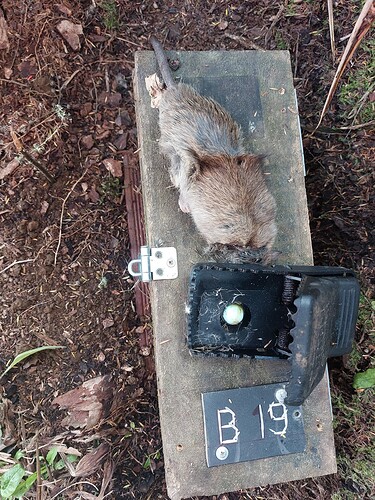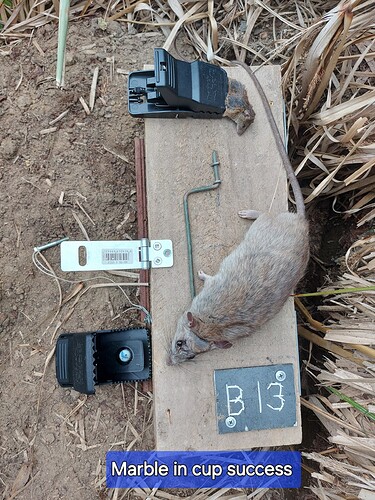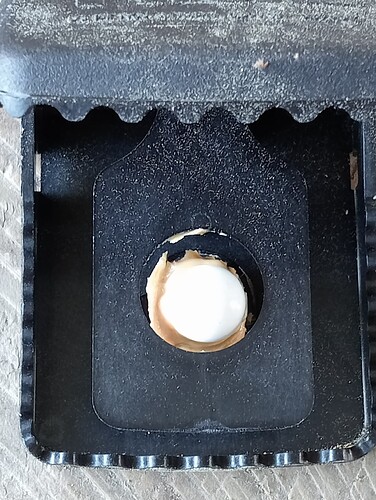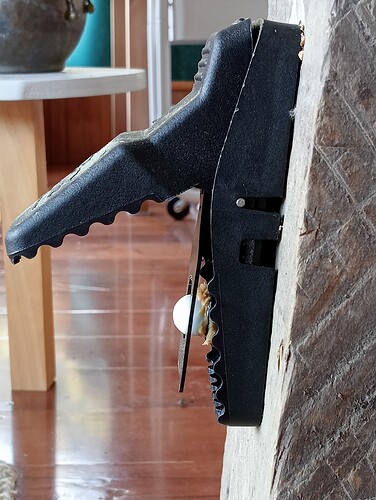The original post was Feb 16, if you want some background.
Between March 9 and September 3, I trapped a total of 40 rats (ship and brown/Norway) in my snap traps trialing the “marble technique” (MT). So far, not a single rat has been able to move or remove a marble from a bait cup without being killed. I was confident that the trial would be successful, but I wasn’t expecting a perfect score!
The difference in performance between the 2 models of snap trap that I used during the trial was significant.
Supervisor Max
The D-Rat Supervisor Max tunnel made by Connovation, was almost perfect during the trial. My 2 Supervisors killed 11 rats between them and at least 40 small rodents. Over 4 months, there was only 1 dry-fire between the two.
D-Rat Supervisor Max – Connovation
Because I use a high concentration of traps, a lot of rats were intercepted by tunnels before they reached one of the Supervisors. If I was using fewer traps, I’m sure that my kill total would have been 30+.
Supervisor Tunnel Tips
1 of my Supervisors is inside a small shed, while the other one is underneath a large Totara. Because Supervisors are made out of light plastic, I mounted mine onto pieces of timber to stabilize them for predators and to make it harder for non-target species to disturb them (like a scavenging cat). The pieces of timber that I used were scraps, the equivalent of a 40cm long piece of 4x2. A thinner piece of timber could be used, provided it’s reasonably heavy.
Supervisors aren’t cheap (about $40) and mounting them onto new timber would make them even more expensive for a single trap, depending on your access to timber. However, if you’re trapping around the house or a small area in the bush, scrub, etc., 1 or 2 Supervisors using the MT, could be very effective. The D-Rat trap’s sensitivity lever, combined with the MT, would allow trappers to reduce small rodent numbers far more effectively than any other model of rat snap trap that I’m aware of.
Notes:
When disarming the D-Rat trap inside a Supervisor, I use my left hand to prevent a dry-fire, by slowing down the setting lever. Using an old sock to fire the trap also works.
Because the D-Rat’s setting bar sticks out to one side, there’s a chance that it won’t fit inside some tunnels.
Any Kess-style model of snap trap should work well with the MT, so you don’t have to buy
D-Rat traps. Being inside a tunnel specifically designed to hold the trap, may make a difference, though.
T-Rexes and Tom Cats
The MT increased my kill rate by about 50% and there was a small increase in small rodent kills, perhaps 25% more than normal. With fewer dry-fires than normal, the odds of creating trap shy predators will have decreased and my traps will have suffered less damage.
When small rodents have been able to consume the excess lure around the base of the marbles, without firing the trap, I’ve still been able to kill rats. Clearly, rats are capable of smelling the lure that remains underneath them marbles, something that I was concerned about when I began the trial. Presumably, even a tiny gap between the base of the marble and the top of the bait cup, is all that’s required for them to detect a lure. With conventional trapping, I’ve never trapped a rat in a snap trap that small rodents and/or insects have completely eaten the lure(s) out of.
Lure Options
The best base lures to use with the MT, are ones that are sticky, because they hold the marble in place. Peanut butter and Nutella are the go-to options for most trappers, but my go-to lure is tallow. It isn’t sticky, but it’s greasy enough that marbles stay put. In cold weather, tallow sets like concrete.
It will be easier for predators, including small rodents, to move marbles if Goodnature lures or egg mayo are used, because they aren’t as sticky, but marbles should still be difficult for predators to move or remove without being trapped.
Cost
Marbles only cost a few cents apiece and will last forever, but some will go missing.
Savings
Using the MT, my edible lures went way further than normal, because they weren’t constantly being eaten by predators, small rodents, and insects during pre-feeds and when my traps were armed.
Underneath the marbles, my lures have stayed fresh for ages, because they’re protected from the elements. In wet/humid weather, the marbles have only allowed a small amount of moisture to reach the lure underneath them (if any), so very little of it gets soggy or goes moldy.
In hot weather, lures can go stale quickly, robbing them of a lot of their scent. Underneath marbles, lures should retain their moisture, keeping their scent fresh. Even inside hot tunnels, it should take a long time for marbles to absorb enough heat for the lures underneath them to be affected. I haven’t used the MT in summer, so I’m waiting to find out how well lures do in the heat.
The amount of lure that I require per trap is way less than normal. Instead of luring every trap for a pre-feed and every trap when they’re armed, once I’ve done a pre-feed, the lure underneath the marble is safe once the traps are set. When I make a kill, I remove the marble from the trap and leave the lure underneath it as a pre-feed. Depending on how much interference your traps experience, the savings could be significant.
Risks?
I’m confident that it will be very difficult for rats and mustelids to move or remove a marble without being killed, but they will be able to remove marbles from tunnels when a trap has been fired by another animal. Some predators will discover that a marble isn’t actually the egg of a small bird, once they’re taken it to their nest or den, but others will find out while they’re still inside a tunnel or near the entrance. Do marbles on the forest floor pose a risk to wildlife?
I contacted several ornithologists, asking if they thought that marbles would pose a risk to kiwi. They didn’t think that kiwi would be harmed, because marbles are perfectly round and smooth. It’s manmade objects like nails and screws that are dangerous to them. Carnivorous birds, like blackbirds and thrushes, will discover that the shell of the egg that they’ve found can’t be cracked, and abandon the marble.
The herpetologist that I contacted, said that lizards, geckos, and skinks aren’t capable of swallowing marbles, even if they wanted to.
Unless you happen to find an abandoned marble inside a tunnel or on the forest floor, it will either be buried away inside a den/nest or disappear into the forest floor over time.
Participation
Please help me to collect more data. I think that I’ve come up with an easy, cheap way to make snap traps more deadly, but I need to find out if my results are normal or out of the ordinary.
Cheers.




